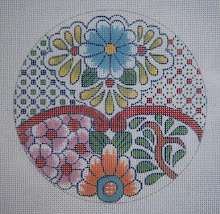 Working on the holly and mistletoe again today after "chores" were finished. (painting)
Working on the holly and mistletoe again today after "chores" were finished. (painting) I am actually rather pleased with the mistletoe! In this version, it looks like the mistletoe of my childhood in the rare years in west Texas where it actually rained enough during the previous summer to produce lots of the little white, waxy berries that make it so pretty at holiday time. There, however, it grew in the mesquite trees rather than oaks - there weren't many of those in Abilene.
I researched the meaning of the holly and mistletoe, as I was curious why they are used as the birthday plants for December - besides the fact that that's when they are at their most beautiful. There are many holiday traditions surrounding the winter solstice, and the Druids believed that anything that grew on the oak tree was sent from heaven - so mistletoe found growing on oaks was especially sacred. In the Celtic language, mistletoe means "All heal" and it was thought to possess miraculous healing powers and hold the soul of the host tree. It was a token of good will and peace when hung over the entry to people's homes.
It is said that when warring Viking armies met under a tree in which mistletoe occurred, they would cease battle for the remainder of that day. Today, many people still hang mistletoe in their homes, and couples kiss when they meet under it. There is a myth associated with this practice that stated if any unmarried women of the household went unkissed during the hanging of the mistletoe, they would not marry in the coming year. Oh Dear!!!

So much for the Winter Soltice celebrations and the legends - This mistletoe was constructed with 4mm silk ribbon from River Silks, with berries made of French knots in 2mm white ribbon. The little green stems were done with 2 plies of Soy Luster.

3 comments:
The mistletoe is my favourite too, it was a good year for it last year where I used to live. Not sure if we'll see any this year
I love your stitched mistletoe, Judy. It looks great!
That is lovely! Very nice, and thanks for the history behind it!
Post a Comment